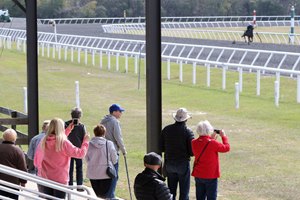How Good Are Sale 2-Year-Olds as Racehorses?


The obvious benefit of acquiring a racehorse through a 2-year-olds in training sale is getting a horse that's already proved it can hold up to training and conditioning. Granted, how a horse ultimately performs in competition is always a question, but handling the stress of a public sale and being fit enough to work a clean eighth- or quarter-mile is no small hurdle cleared.
As might be expected, juveniles sold at auction find the winner's circle with greater frequency than the 2-year-old population overall.
Research compiled by BloodHorse MarketWatch shows 78% of the 2-year-old horses sold at auctions from 2000-17 went on to start in a race and 76% of those runners became winners. By comparison, of all the named 2-year-olds representing the same crops as the sale horses, and including the sale horses, 69% became runners collectively and 67% of those runners became winners.
But what about the quality of the runners? MarketWatch wondered whether the 2-year-olds sold at auction performed any better than their corresponding crops as a whole. Performance records show the sale horses have the edge here, too.
Among the horses sold during 2000-17 North American 2-year-olds in training auctions, 37,988 went on to start in a race and 6% of them became black-type winners. The runners also earned $66,976 on average. MarketWatch only considered racing statistics through the 2017 sale year because we wanted to capture lifetime race records at least through the horses' sophomore years.
For all juveniles during the same period, 3.9% of 389,637 runners went on to become black-type winners, and they collectively averaged $49,218 in earnings.
Chart: Performance Comparison of Juveniles Sold at Auction vs. All Juveniles, 2000-17
Two-year-olds in training sales were conceived in Florida in the 1950s as a way to sell horses with unfashionable or downright poor pedigrees. The horses back then had to prove their worth on the track. Over time, the 2-year-olds in training sales morphed into their own market, driven largely by yearling-to-juvenile pinhookers who capitalized on the potentially lucrative increase in value a horse can realize between when it's a yearling to when it's a budding racehorse.
Just in the last five years, the 2-year-olds in training market has matured substantially. From 2000 through 2012, the juveniles sold at auction in North America represented 8.1% of all named foals for the crops represented. The percentage of juveniles sold rose to 9.5% for the 2013 sale year and jumped again to 11.6% in 2014. During the 2014-18 sale years, the percentage of sales 2-year-olds from all 2-year-olds averaged 10.9%.
Average 2-year-old price has also grown substantially. Juveniles in training sold during the 2000-13 sale years averaged $55,061 compared with a $78,105 average during 2014-2018.
Fortunately, the average earnings of these 2-year-olds sold has grown, too. Horses sold as juveniles during 2000-13 went on to earn an average $67,083 as racehorses. Horses sold during the 2014-17 sales (with the youngest ones now 4) have averaged $69,248 in earnings.
Finding the good, let alone elite, racehorse is always a challenge, but the 2-year-olds in training market has proved to be valuable shopping territory for any owner or agent.
